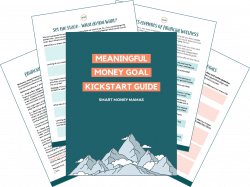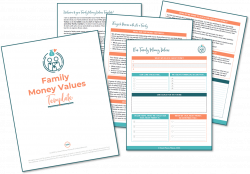
5 Money Goals That Need a High-Yield Savings Account
A high-yield savings account should be a tool in every family’s financial plan, especially for short- to medium-term goals. But

So you’ve got a spending problem. Welcome to the club.
There’s good news and bad news.
Bad news first, right? If you have a spending problem, you’re probably trying to find a way to fill an emotional gap in your life.
You can’t just hope to find more willpower and white-knuckle your way through.
The good news? When we do the work of getting to the root of the emotional issue, spending falls away. We can heal, and make use of good habits, tools, and draw upon our community.
Emotional spending is a common problem, but no two people struggle the same way. We all have our own triggers for spending, our own places where that overspending manifests.
On a high-level, it’s defined as buying things you don’t need as a result of stress, boredom, jealousy, guilt, insecurity, fear-or really any negative emotion.
That sounds… miserable.
Luckily, if you can take the time to understand where your emotions are coming from, you can make a plan for how you’ll respond to those emotions when they rear their ugly heads – and avoid them for the long-term. That’s what I want to help you do.
Because if you can’t control your emotional spending, purchases that may feel small in the moment, derail us from our bigger goals. And it leaves you feeling stressed, guilty, and regretful – and that’s not the relationship with money you deserve.
Here are five tips to help you reduce your emotional and impulse spending and change your emotional spending cycle.
On the surface, emotional and mental health spending might seem like the same thing. But in reality, one is spending where you’re trying to fill an emotional hole with stuff. The other is spending because you need extra support to take care of yourself when you’re struggling with anxiety, depression, or other bigger issues.
Generally speaking, people who struggle with anxiety and depression spend more than people that don’t.
For example, as someone who has struggled with anxiety and depression, if I’m maxed out at the end of a stressful day, there’s a good chance that I am going to order out instead of cooking. Some days, I simply don’t have it in me to cook and my family still has to eat.
If you are facing similar challenges, I don’t want you to feel any shame over choices like that.
I definitely don’t want you avoid investing in those supports – babysitting, ordering out, or having the house cleaned. I want you to be able to have those breaks when you need them. Instead, I just want to help you plan for them.

Grab our free Meaningful Money Goal Kickstart Guide and start setting goals you’ll love and achieve!
When it comes to mental health spending, I suggest having an A/B budget. The A budget is for when you’re mentally healthier and don’t need to rely on those extra expenses to get you through.
The B budget would include those extra supports and pulls back on savings a bit.
You can smooth the gaps between these budgets by creating sinking funds for your mental health spending. Setting aside money each month, just for those mental health expenses, to use when you need it.
Just remember to keep making the distinction between mental health and emotional spending. Emotional spending is just trying to put a Band-Aid on a deeper issue whereas mental health spending is using money as a tool to move out of your overwhelm more effectively.
There are a million reasons why we spend and a million different triggers that make us spend.
We’re happy, so we want to celebrate.
We feel guilty, so we want to pay for that friend who covered our meal last time.
We’re bored, so we want to something to do right now.
A lot of these triggers boil down to stress and exhaustion. And when we are stuck in seasons of stress and exhaustion, these spending patterns become embedded habits. And our overspending becomes automatic.
So how do you do the work of identifying these triggers?
Spend a couple weeks journaling about your expenses and how they make you feel. Take some time to answer two questions about your spending each day: how did you feel in the moment when you made that expense? And how did you feel now, after you’ve made the purchase?
Try to identify patterns in your behavior and your go-to spending weaknesses.
Do you spend more on certain days of the week? When you’re spending time with certain people
Do you consistently get unplanned takeout on the night your kid has soccer practice?
Get clear and specific on your triggers.
This needs to be the first step. Because if you’re not aware of when and why you’re spending, you’ll be fighting an invisible force.
RELATED: Why is Self-Care So Hard For Moms?
So now that you know all the reasons you’re spending emotionally (or at least a good list to start with), now we have to find a way to reroute those behaviors.
After talking to hundreds and hundreds of mamas, what I’ve found is that rerouting emotional spending is really about understanding the value of self-care.
As complex as our emotions are, we tend to do our worst when we are worn down and exhausted.
First, it’s critical then to have a baseline of regular self-care.
How do you make sure you are eating healthy, getting enough sleep, and giving yourself time to enjoy something you love? Create a plan to make more time for yourself in your daily schedule.
Start small, creating new habits is hard, but the change will be worth it.
Second, make a list of things you can do for yourself when you hit that low point and are really feeling the pull to spend.
Go outside and take a walk. Journal. Reach out to a friend. Have a 2-minute dance party to your favorite song. Keep a list of your quick grounding exercises somewhere you’ll easily see it on a regular basis, so you’re cued to try those things before heading to Amazon.
Because ultimately, material things aren’t going to make you feel more valued or less stressed.
If you’re tired, Starbucks is not actually the answer. (Sorry!) Getting to bed earlier though? That could actually help. Try to find a way to match the emotion with the underlying need.
While awareness is your #1 resource for curbing emotional spending, there are a few hacks you can use to make it harder to spend money impulsively.
For one, never allow a website, (especially Amazon) to save your credit card information. Just making yourself go the extra step of entering the card could number be enough to make you recognize your emotional spending.
Another trick is to unsubscribe from sales emails. If you aren’t seeing the sales roll in your inbox every day, you’re going to be much less tempted to buy.
For your debit or credit card, try keeping a sticky note on your card so that every time you pull it out, it’s one more reminder that you are spending and one more chance to reconsider your decision. (Bonus points – Write “How are you feeling?” or another check in question on the sticky note!)
Lastly, try implementing the 24 hour rule. For any purchase, be it $10 or $300, make a rule to wait for 24 hours. Is it still just as important? Are you even thinking about it anymore? Did the sale really go away? Chances are, if the expense was unnecessary or driven by emotion, you’ll have forgotten about it by the next day.
Even if you’ve put steps 1-3 into place and getting really consistent with using these strategies, you’re going to have times when emotional or impulsive spending gets the better of you. So make space in your budget for that.
You have a bad day and you grab a cute top at Target because it’s a small joy.
You want to take the kids for ice cream because it’s a beautiful day, but your Family Activity budget is tapped.
Lean on a small Life Happens category in your budget.
Perfection isn’t the goal here. Instead, simply be more aware of when emotional spending is taking over and pay attention to staying within your Life Happens budget category. That way, your spending won’t derail your important goals.

Grab our free Family Money Values Template and create a strong foundation for your family’s healthy money habits!
This one is really critical. Earlier we discussed that emotional and impulsive spending is often driven by stress and exhaustion. But there are two other big emotions that are frequently at play.
Guilt and jealousy.
Those emotions don’t have anything to do with true lack in our own lives. Instead, they come from our relationships with other people, with money and our feeling of worthiness.
Other people’s priorities and actions distract us from our own.
Your neighbor gets a new car and you start looking at your car differently.
Not to mention the daily triggers, like the end rack of adorable Joanna Gaines home decor at Target, which makes us think of all the expectations around how our homes “should” look.
Often our surroundings are trying to distract us from our end goal. So you need to create an environment that reminds you what is uniquely important to you and your family.
Use the Family Money Values Template to dig in and discover what your family is committed to when it comes to spending your money.
Post your goals on the fridge or make your money mantra the background on your phone. Create a vision board for the life you’re building.
Do anything you can to focus on what matters most to you.
All of this is practice. We’re looking for progress, not perfection.
Remember that your feelings may seem overwhelming and inconvenient in the moment, but when we slow down and pay attention, we’re likely to find that they’re providing sign posts for what our bodies and souls really need.
As you go through these exercises and implement these strategies, you’re likely to find out something surprising. You don’t have a spending problem. You have a human problem. A self-care problem.
Aligning your spending with your values isn’t about struggling against overspending forever. It’s about finding awareness, making the time to take care of yourself, and creating a vision for your future that excites you enough to say no to short-term pleasures.
You’ve got this, mama!
Why not practice now? What are your emotional spending triggers? What is one way you could reroute that trigger to avoid unnecessary spending? Share with us in the comments!
Are you subscribed to the Smart Money Mamas podcast? If you’re not, I want to encourage you to head over to Apple Podcasts (or wherever you listen to your podcasts) and subscribe! I release episodes twice and week and as a subscriber, you’ll be notified right away so you can take checking the feed for new content off your mental to-do list.
Click here to subscribe on Apple Podcasts, Google Podcasts, or Spotify!




A high-yield savings account should be a tool in every family’s financial plan, especially for short- to medium-term goals. But

Ever have a witty t-shirt idea and think, “Hey, I could totally make money off that?” Or wanted to design

“I could never use Qube Money because I love getting credit card points for my spending!” This is the number
Important Links
Find What You Need
Copyright © 2020 Smart Money Mamas · All Rights Reserved